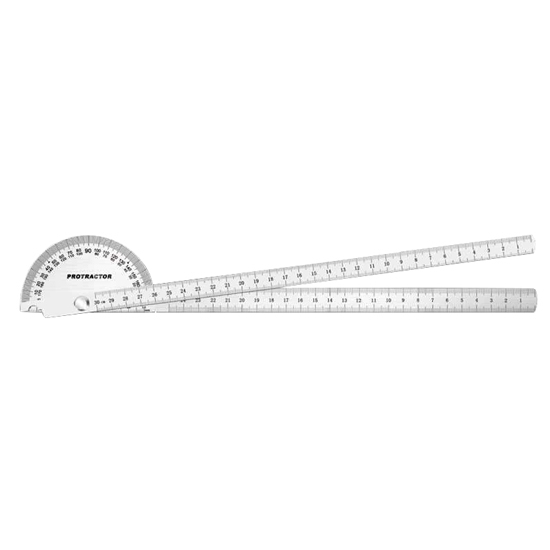
Two Arm Stainless Steel Angle Protractor, 90x300mm
from
$29.67
Ex Tax: $29.67
- Stock: In Stock
- Model: RDDLZ-AP-TA300
- Weight: 1.00
- SKU: RDDLZ-AP-TA300
Available Options
Create unlimited custom product blocks and display them in accordions or tabs or open blocks. Each block can be assigned to all products at once or specific products according to advanced criteria.
Create unlimited custom product blocks and display them in accordions or tabs or open blocks. Each block can be assigned to all products at once or specific products according to advanced criteria.
Low price metal protractor, size 90x300mm, allows the user to plot at a fixed angle and is suitable for setting mitres, drawing radial lines, measuring and marking angles. Its two arms allow for precise angle measurements, making it a must-have tool for carpenters, engineers, DIY enthusiasts and more.
Specification
- Model: RDDLZ-AP-TA90300
- Measuring Range: 0-180 degrees
- Size: 90x300mm
- Total Body Length: 359mm
- Diameter of Disc: 90mm
- Width: 13/17mm
- Body Thickness: 1.2mm
- Weight: 160g
Features
- 90x150mm Stainless steel angle protractors are highly accurate and precise in measuring angles, ensuring that your measurements are as close to perfect as possible.
- The 180-degree angle finder ruler has a laser scale for accurate and practical reading.
- The two arm stainless steel construction of angle protractors makes them very durable and resistant to wear and tear, ensuring they can withstand frequent use and last for a long time.
- RDDLZ two arm stainless steel angle protractor is lightweight and compact, making them easy to carry around and use on the go.
Scribing method
- Adjust the protractor to the right angle and tighten the nut.
- Draw the desired angle and figure along the edge of the ruler.
Measuring Method
- Fit the protractor measurement close to the work.
- Adjust the semicircle to fit the other side of the workpiece.
- Just take a reading.
Dimension (Unit: mm)
Applications
Angle protractors are commonly used in fields such as construction, engineering, and carpentry to measure angles for cutting and fitting materials. They are also used in mathematics and physics to solve problems involving angles and trigonometry.
Tips: What are some tips for using an angle protractor effectively?
- Understand the different parts of the angle protractor: Most angle protractors have two arms, one of which is fixed while the other is adjustable. The adjustable arm is used to measure the angle, while the fixed arm is used as a reference point.
- Place the protractor correctly: Place the protractor on the angle to be measured with the fixed arm aligned with one of the sides of the angle.
- Read the angle measurement: Read the measurement from the scale on the adjustable arm of the protractor. Make sure to read the angle from the correct scale, either degrees or radians.
- Use a straight edge: When drawing an angle, use a straight edge to draw the sides of the angle, making sure to align the straight edge with the reference line on the angle protractor.
- Double-check the measurement: After measuring or drawing an angle, double-check the measurement to make sure it is accurate. Check that the angle measurement is consistent with the known properties of the angle, such as the sum of the angles in a triangle adding up to 180 degrees.
Builder in Product TAB
NEW! Since Journal 3.2, the much improved T.A.B (Tabs Accordion Blocks) system supports the page builder inside the tab content. Unlimited Blocks, Tabs or Accordions with any HTML content or the builder interface (supporting custom rows/columns/modules) can be assigned to any individual product or to certain groups of products, like entire categories, brands, products with specific options, attributes, price range, etc.
You can indicate any criteria via the advanced product assignment mechanism and only those products matching your criteria will display the modules.
Also, any module can be selectively activated per device (desktop/tablet/phone), customer login status and other criteria. Imagine the possibilities.
